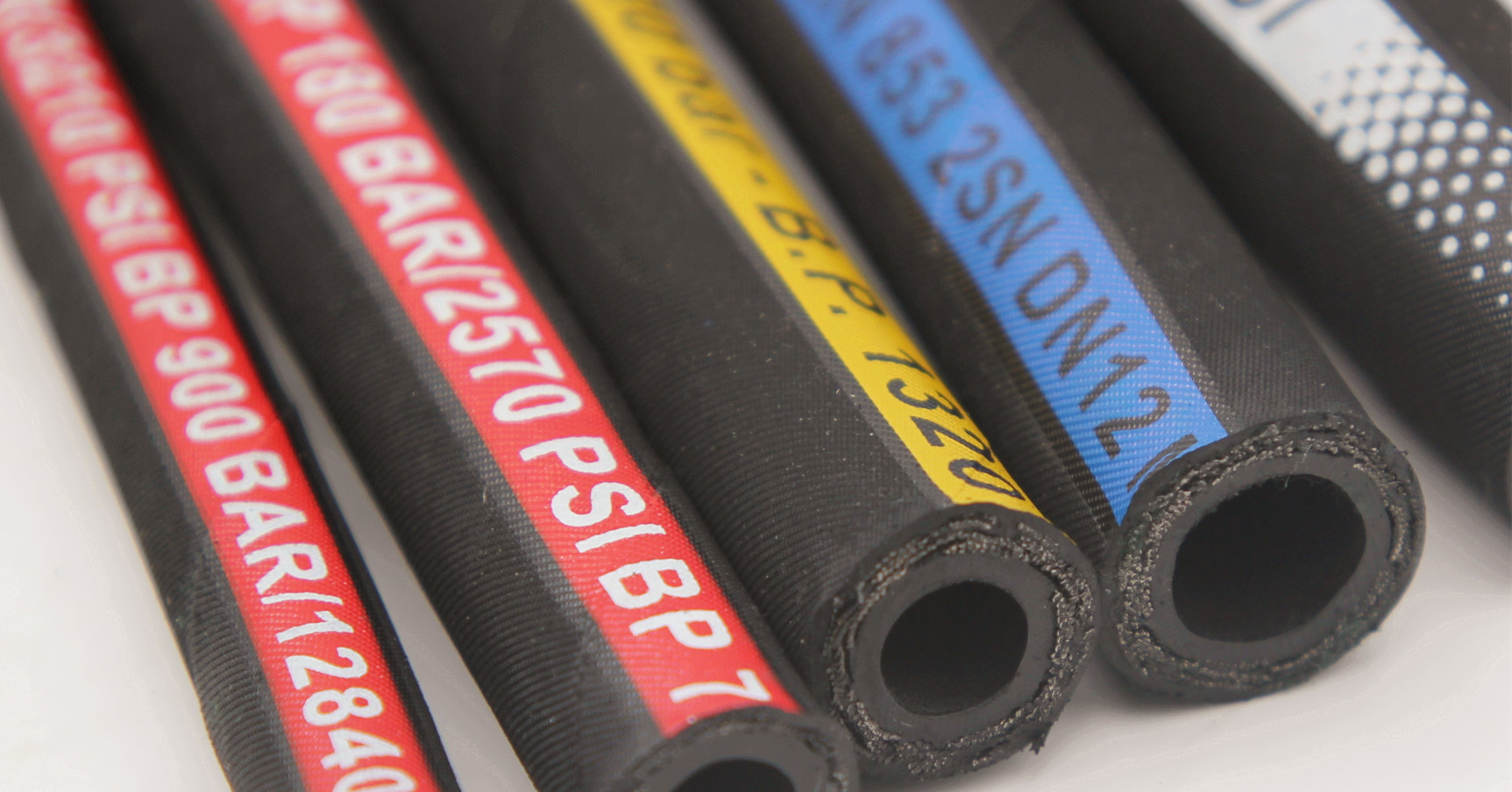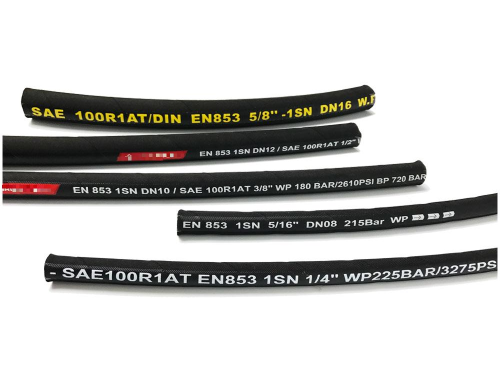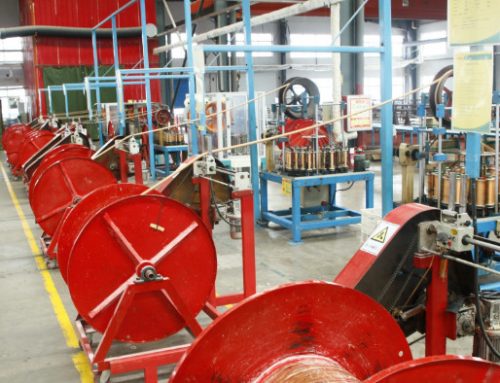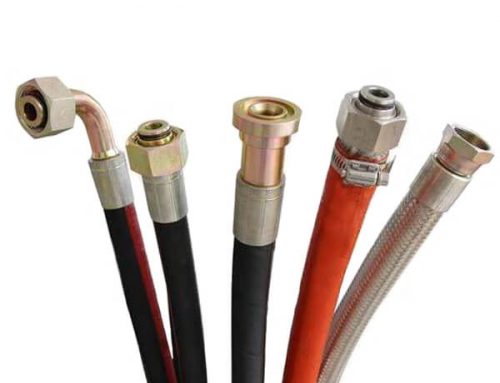A high pressure hydraulic hose is an essential component in hydraulic systems that transmit power using pressurized fluid. It is designed to withstand high pressure and deliver hydraulic fluid efficiently. In this article, we will explore what high pressure hydraulic hoses are made of, their maximum pressure capabilities, the appropriate size for high pressure applications, and how to select the right high pressure hydraulic hose.

WHAT IS HIGH PRESSURE HYDRAULIC HOSE MADE OF
High pressure hydraulic hoses are typically made of synthetic rubber or thermoplastic materials. These materials are chosen for their durability, flexibility, and resistance to hydraulic fluids. The inner tube of the hose is reinforced with multiple layers of braided or spiral-wound wire, providing strength and preventing the hose from bursting under high pressure.
High pressure hydraulic hoses are typically constructed using a combination of different materials that work together to withstand the extreme pressures involved in hydraulic applications. The primary material used in the construction of these hoses is synthetic rubber, specifically designed to have high tensile strength and resistance to abrasion, chemicals, and temperature fluctuations.
To enhance the strength and flexibility of the hose, reinforcement layers are added. These reinforcement layers are usually made from high-strength materials such as steel wire or textile braids. Steel wire braids provide excellent resistance against high-pressure conditions, while textile braids offer flexibility and ease of handling.
In addition to the core materials, high pressure hydraulic hoses may also feature protective covers. These covers serve as an outer layer that shields the hose from external factors such as UV radiation, moisture, and physical damage.
Overall, high pressure hydraulic hoses are carefully engineered using a combination of synthetic rubber, reinforcement layers, and protective covers to ensure optimal performance under demanding conditions. By understanding what these hoses are made of, users can make informed decisions when selecting the right hose for their specific application requirements.
MAXIMUM PRESSURE
The maximum pressure rating of a high pressure hydraulic hose depends on its construction and materials. It is important to choose a hose with a maximum pressure rating that exceeds the operating pressure of the hydraulic system it will be used in. Failure to do so can lead to hose failure, leaks, and potential damage to the equipment.
The maximum pressure rating of a high-pressure hydraulic hose determines its capability to handle the force exerted by the fluid within the system. It is imperative to select a hose with a maximum pressure rating that meets or exceeds the requirements of your specific application.
By choosing a high-quality high-pressure hydraulic hose with an appropriate maximum pressure rating, you can minimize the risk of hose failure and ensure reliable operation under demanding conditions. This not only enhances safety but also contributes to increased productivity and efficiency in your operations.
In conclusion, understanding and adhering to the maximum pressure specifications of high-pressure hydraulic hoses is vital for maintaining operational integrity and preventing potential hazards. Make sure to consult industry standards and guidelines when selecting and using these hoses to ensure optimal performance and safety in your applications.
WHAT SIZE HOSE FOR HIGH PRESSURE
When it comes to high-pressure applications, choosing the right size hose is crucial for optimal performance and safety. The size of the hose plays a significant role in determining its ability to handle high pressure effectively.
To determine the appropriate size hose for high-pressure applications, several factors need to be considered. These include the flow rate, operating pressure, temperature, and viscosity of the fluid being transported.
A larger diameter hose generally allows for higher flow rates and lower pressure drop, making it suitable for applications requiring a significant volume of fluid transfer. On the other hand, a smaller diameter hose may be more suitable for applications where space is limited or where precise control over flow rate is necessary.
It is essential to consult industry guidelines or seek professional advice when selecting the appropriate size hose for high-pressure applications. This ensures that you choose a hose that can withstand the required pressure without compromising on safety or efficiency.
By carefully considering these factors and seeking expert guidance if needed, you can confidently select the right size hose for your high-pressure needs.
APPLICATION
One of the key applications of high pressure hydraulic hoses is in heavy machinery and equipment. These hoses are designed to withstand tremendous amounts of pressure, ensuring the safe and efficient operation of machinery such as cranes, excavators, loaders, and forklifts. They enable the transmission of hydraulic fluid to power different functions, such as lifting heavy loads or operating attachments.
In the construction industry, high pressure hydraulic hoses play a vital role in powering hydraulic tools like jackhammers, concrete breakers, and compactors. These hoses can handle the intense vibrations and pressures generated by these tools, ensuring reliable performance on construction sites.
Moreover, high pressure hydraulic hoses find extensive use in manufacturing plants where precision is crucial. They are employed in automated machinery for processes like metal stamping, plastic injection molding, or assembly lines where precise control over movements is necessary.
The transportation sector also relies heavily on high pressure hydraulic hoses for various applications. From commercial vehicles like trucks and buses to aircraft landing gear systems or even ships’ steering mechanisms – these hoses ensure smooth operations by transferring power efficiently under extreme conditions.
In summary, high pressure hydraulic hoses have diverse applications across industries where reliable transmission of power is essential. Their ability to withstand immense pressures makes them indispensable components in heavy machinery, construction equipment, manufacturing plants, and transportation systems. By enabling efficient power transfer with utmost reliability, these hoses contribute significantly to the smooth operation of various industrial processes.
HOW TO SELECT HIGH PRESSURE HYDRAULIC HOSE: THE GUIDE(2023)
When it comes to selecting a high-pressure hydraulic hose, making the right choice is crucial for the smooth and safe operation of your hydraulic system. With so many options available in the market, it can be overwhelming to determine which hose is the best fit for your specific needs. However, by following a few key guidelines, you can ensure that you select a high-quality hose that meets all your requirements.
Firstly, consider the pressure rating of the hydraulic hose. This is perhaps one of the most important factors to consider as it determines the maximum pressure that the hose can handle. It is essential to choose a hose with a pressure rating that exceeds or matches the maximum operating pressure of your hydraulic system.
Secondly, take into account the compatibility of materials. Hydraulic hoses are typically made from different materials such as rubber, thermoplastic, or synthetic fibers. It is crucial to ensure that both the inner tube and outer cover material are compatible with the fluid being conveyed in your hydraulic system. Chemical compatibility should also be considered if there are any specific fluids or chemicals involved.
Next, evaluate factors such as temperature range and flexibility. High-pressure hydraulic hoses may be subjected to extreme temperatures and need to withstand these conditions without compromising performance. Ensure that you select a hose with an appropriate temperature range suitable for your application.
Additionally, consider factors like flexibility and bend radius requirements. Depending on your application’s layout and space constraints, you may need a hose with greater flexibility or specific bend radius capabilities.
Lastly, don’t overlook industry standards and certifications when selecting a high-pressure hydraulic hose. Look for hoses that comply with recognized standards such as SAE (Society of Automotive Engineers) or ISO (International Organization for Standardization). These certifications ensure that the hoses meet stringent quality and performance standards.
By carefully considering these factors – pressure rating, material compatibility, temperature range, flexibility requirements, and industry certifications – you can confidently select a high-pressure hydraulic hose that will deliver optimal performance, reliability, and safety for your hydraulic system.



